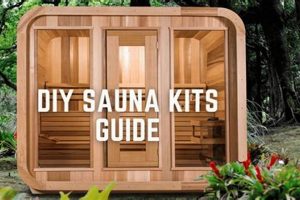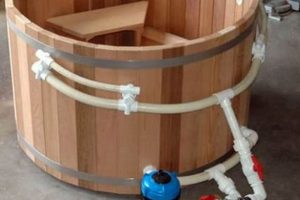These structures represent pre-packaged sets of materials and instructions designed to facilitate the construction of small, often rustic, dwellings by individuals. They typically include lumber, windows, doors, and roofing materials, accompanied by detailed plans. A consumer, for example, might purchase one to erect a weekend retreat in a rural setting.
The rise in popularity of these offerings reflects a confluence of factors, including increased interest in sustainable living, a desire for affordable housing alternatives, and the satisfaction derived from hands-on construction projects. Historically, the concept of self-built housing has existed for centuries, but advancements in prefabrication and simplified designs have made the process more accessible to a wider range of individuals.
Understanding the different types available, the permitting processes involved, and the necessary skill sets for successful assembly is paramount for prospective buyers. Furthermore, considering factors such as site preparation, foundation options, and long-term maintenance is crucial for ensuring the durability and functionality of the finished structure.
Essential Considerations for Self-Assembly Cabin Projects
Successful execution of a self-assembly cabin project hinges on thorough planning and meticulous execution. The following points highlight critical aspects to consider prior to and during the building process.
Tip 1: Site Assessment is Paramount: Before ordering any materials, a comprehensive site evaluation is essential. This includes assessing soil stability, drainage patterns, and potential environmental impacts. Professional surveying may be required to determine property lines and ensure compliance with local zoning regulations.
Tip 2: Scrutinize the Contents: Upon delivery, meticulously inventory all components against the provided packing list. Document any discrepancies or damages immediately and contact the supplier. Failure to do so may result in project delays and added expenses.
Tip 3: Adherence to Plans is Non-Negotiable: Strictly follow the manufacturer’s instructions. Deviations from the specified procedures can compromise the structural integrity of the building. If uncertainty arises, consult a qualified building professional.
Tip 4: Foundation Preparation: A stable and level foundation is crucial. Depending on soil conditions and local codes, options may include concrete slabs, pier and beam systems, or gravel pads. Ensure proper compaction and leveling prior to beginning assembly.
Tip 5: Invest in Proper Tools: Utilize appropriate tools for each stage of construction. This may include power drills, saws, levels, and measuring tapes. Renting specialized equipment, such as a post-hole digger, may be more cost-effective than purchasing.
Tip 6: Weather Protection During Construction: Protect materials from exposure to the elements during the building process. Cover lumber and other components with tarpaulins to prevent warping, cracking, or water damage. Schedule construction phases to minimize disruption from inclement weather.
Tip 7: Secure Necessary Permits: Research and obtain all required building permits before commencing work. Failure to comply with local regulations can result in fines, stop-work orders, or even demolition of the structure.
Adherence to these guidelines will enhance the likelihood of a successful construction, resulting in a durable and functional structure. Prioritizing planning and diligent execution is key.
The considerations outlined above serve as a framework for approaching these projects. The subsequent sections will further explore specific design choices and customization options.
1. Planning & Permitting
Diligent planning and acquisition of necessary permits are prerequisites for any construction project, particularly regarding self-assembly cabins. These stages ensure compliance with local regulations, safeguard structural integrity, and mitigate potential legal ramifications.
- Zoning Regulations and Land Use Restrictions
Local zoning ordinances dictate permissible land usage and building restrictions. These regulations may impose limitations on cabin size, setbacks from property lines, height restrictions, and allowable construction materials. Non-compliance can lead to fines, legal action, or mandatory demolition of the structure. Reviewing zoning maps and consulting with local planning authorities is critical before initiating any building activities.
- Building Codes and Safety Standards
Building codes establish minimum standards for structural safety, fire resistance, and energy efficiency. They dictate construction practices, material specifications, and inspection requirements. Failure to adhere to these codes can compromise the safety of occupants and expose the property owner to liability. Obtaining the correct permits triggers inspections by building officials to ensure compliance with these standards. The International Residential Code (IRC) is a commonly adopted model code for one- and two-family dwellings and may serve as the basis for local requirements.
- Environmental Regulations and Impact Assessments
Construction activities can impact the environment through soil erosion, water pollution, and habitat disturbance. Certain jurisdictions mandate environmental impact assessments to evaluate potential ecological consequences and implement mitigation measures. Regulations may restrict construction near wetlands, waterways, or protected species habitats. Failure to comply with environmental regulations can result in significant penalties and project delays.
- Permit Application Procedures and Documentation Requirements
The process of obtaining building permits typically involves submitting detailed architectural plans, site surveys, and engineering calculations to the local permitting authority. These documents must demonstrate compliance with applicable zoning regulations and building codes. The permitting authority reviews the application and may require revisions or additional information before issuing a permit. The process can be time-consuming and require professional expertise, but is essential for legitimizing the construction project.
The intersection of planning, permitting, and self-assembly cabins underscores the necessity of thorough preparation. Neglecting these crucial stages can lead to significant financial losses, legal entanglements, and safety hazards. Engaging with local authorities early in the process ensures that the project proceeds smoothly and adheres to all applicable regulations. Thorough planning and permitting are not mere formalities; they are fundamental safeguards for the homeowner and the community.
2. Foundation Integrity
The fou
ndation serves as the critical interface between a self-assembly cabin and the ground, transferring the structure’s load and resisting external forces. Deficiencies in foundation integrity directly compromise the cabin’s stability, longevity, and overall performance. A compromised foundation in a DIY cabin project precipitates a cascade of negative effects, ranging from structural instability and premature deterioration to compromised weather resistance and potential safety hazards. Selecting the appropriate foundation type, executing proper site preparation, and adhering to established construction practices are therefore paramount for ensuring the successful outcome and long-term viability of any DIY cabin endeavor.
Different foundation types exhibit varying degrees of suitability depending on site conditions, soil characteristics, and local climate. Concrete slabs, for example, offer a stable and level surface but require extensive excavation and may be susceptible to cracking in expansive soils. Pier and beam systems provide elevation above ground level, mitigating moisture issues and allowing for ventilation, but demand precise alignment and bracing. Screw piles offer a rapid installation method with minimal soil disturbance, but may not be appropriate for all soil types or load-bearing requirements. A poorly executed foundation leads to uneven settling, causing doors and windows to jam, walls to crack, and the overall structural integrity to be compromised. The practical significance of understanding the relationship between foundation integrity and a cabin’s performance is underscored by the potential for costly repairs, reduced property value, and, in extreme cases, structural failure.
In summation, foundation integrity is not merely a construction detail, but rather the bedrock upon which the entire self-assembly cabin project rests. While these offerings present an accessible entry point to cabin construction, the foundation component necessitates meticulous planning, careful execution, and, when necessary, consultation with qualified professionals. Prioritizing foundation integrity safeguards the investment, ensures occupant safety, and contributes to the long-term enjoyment of the finished structure.
3. Material Quality
The correlation between the quality of materials and the longevity, safety, and overall satisfaction derived from self-assembly cabin projects is demonstrably strong. The use of substandard materials can initiate a cascade of problems, ranging from premature structural degradation to increased maintenance costs and potential safety hazards. For example, utilizing untreated lumber in a damp environment invites rot and insect infestation, weakening the frame and compromising its load-bearing capacity. Conversely, selecting pressure-treated lumber, engineered wood products, or naturally durable species like cedar can significantly extend the lifespan of the structure. Similarly, inadequate roofing materials can lead to leaks, water damage, and mold growth, necessitating costly repairs. The choice of low-grade windows and doors compromises insulation, leading to increased energy consumption and reduced comfort. Material quality is, therefore, not merely an aesthetic consideration but a fundamental determinant of the cabin’s long-term performance.
The practical significance of understanding material quality is exemplified by considering the total cost of ownership. While cheaper materials may reduce the initial purchase price, they often lead to higher maintenance expenses, shorter lifespans, and reduced resale value. Selecting higher-quality materials upfront can translate into long-term savings by minimizing repairs, replacements, and energy consumption. Furthermore, superior materials enhance the cabin’s resilience to extreme weather events, providing greater peace of mind and security. For example, a cabin constructed with impact-resistant windows and reinforced framing is better equipped to withstand high winds and heavy snow loads. Another aspect of material quality pertains to its environmental impact. Opting for sustainably sourced lumber, recycled materials, and low-VOC paints contributes to a more environmentally responsible construction process. This is especially important for those seeking a harmonious integration of their cabin with the natural surroundings.
In summary, the selection of appropriate, high-quality materials is a critical determinant of the success of self-assembly cabin projects. While budget constraints often influence material choices, prioritizing durability, weather resistance, and sustainability can yield significant long-term benefits. A comprehensive understanding of material properties, coupled with careful consideration of environmental factors and lifecycle costs, is essential for ensuring a safe, comfortable, and enduring cabin structure.
4. Assembly Expertise
The successful completion of self-assembly cabin projects hinges significantly on the level of assembly expertise possessed by the builder. While the kits are designed to simplify construction, a foundational understanding of building principles, coupled with practical skills, directly influences the quality, safety, and longevity of the finished structure. Insufficient expertise can lead to structural weaknesses, improper installation of critical components, and ultimately, project failure. For instance, incorrect framing techniques can compromise load-bearing capacity, while improper sealing can result in water damage and mold growth. The relationship between assembly expertise and the success of these projects is, therefore, a causal one: a higher degree of expertise correlates with a greater likelihood of a structurally sound and durable cabin. The kits themselves provide instructions, but they cannot replace the nuanced understanding and problem-solving abilities that an experienced builder brings to the table.
Real-world examples abound of projects where a lack of assembly expertise led to significant complications. Cases involving improperly installed roofing systems, resulting in extensive water damage, or foundations built without adequate support, leading to structural instability, serve as cautionary tales. Conversely, projects undertaken by individuals with prior construction experience or those who invested in professional guidance often demonstrate superior build quality and fewer post-construction issues. This underscores the practical significance of assessing one’s own skill level and seeking assistance when necessary. Such assistance might include hiring a qualified contractor for specific tasks, consulting with a structural engineer, or enrolling in relevant training courses. The value of this investment lies in mitigating the risks associated with inadequate assembly expertise and ensuring that the cabin is built to withstand the elements and meet applicable building codes.
In conclusion, while self-assembly cabin offerings democratize the process of cabin construction, they do not obviate the need for assembly expertise. Project success depends on a realistic assessment of one’s own capabilities and a willingness to seek guidance when needed. The challenges associated with inadequate expertise can be overcome through diligent preparation, investment in training, and, when appropriate, collaboration with qualified professionals. Recognizing the importance of assembly expertise is, therefore, a critical step towards realizing the dream of a structurally sound and aesthetically pleasing self-built cabin.
5. Maintenance Strateg
ies
The long-term viability of structures assembled from do-it-yourself (DIY) cabin packages is intrinsically linked to the implementation of proactive maintenance strategies. Neglecting routine upkeep can negate the cost savings and personal satisfaction derived from self-construction, ultimately leading to premature deterioration and costly repairs. The materials used, the climate in which the cabin is situated, and the quality of the initial assembly all influence the specific maintenance needs, but a consistent program of inspection, repair, and preventative treatment is universally necessary. For example, a cabin constructed from untreated lumber in a humid environment is highly susceptible to rot and insect infestation if not regularly inspected and treated with preservatives. The absence of properly sealed seams and flashing around windows and doors can result in water intrusion, leading to mold growth and structural damage. Therefore, maintenance is not merely an afterthought but an essential component of the overall DIY cabin endeavor.
Effective maintenance strategies encompass several key areas. Regular inspections, ideally conducted seasonally, should focus on identifying potential problems such as damaged roofing, cracked siding, and signs of insect activity. Prompt repairs are crucial to prevent minor issues from escalating into major structural defects. Preventive treatments, such as applying sealant to exposed wood surfaces and cleaning gutters to ensure proper drainage, can significantly extend the lifespan of the cabin. Furthermore, interior maintenance, including regular cleaning and pest control, contributes to a healthy and comfortable living environment. The choice of maintenance products should align with the materials used in construction. For instance, using oil-based stains on cedar siding helps to preserve its natural beauty and protect it from the elements. Consistent implementation of these strategies ensures the continued performance and aesthetic appeal of the cabin.
In summary, the adoption of proactive maintenance strategies is paramount for maximizing the investment in DIY cabin packages. While the initial construction phase receives considerable attention, ongoing maintenance often receives insufficient emphasis. By implementing a comprehensive maintenance program, homeowners can mitigate the risk of costly repairs, extend the lifespan of their cabins, and preserve the value and enjoyment derived from these unique structures. This proactive approach transforms a self-built cabin from a weekend project into a durable and cherished asset.
Frequently Asked Questions
This section addresses common inquiries regarding self-assembly cabin packages, providing concise and informative answers to assist prospective buyers.
Question 1: Are all necessary materials included in the typical package?
The inclusion of materials varies by manufacturer and package level. A comprehensive package typically includes framing lumber, sheathing, roofing, windows, doors, and basic hardware. However, foundations, electrical wiring, plumbing, insulation, and interior finishing are often excluded and must be sourced separately.
Question 2: What level of construction experience is required for successful assembly?
While these offerings are designed for self-assembly, a certain level of construction competency is beneficial. Familiarity with basic carpentry tools, framing techniques, and blueprint reading is highly recommended. Individuals lacking experience may consider professional assistance or enrolling in relevant training courses.
Question 3: Are building permits required for self-assembly cabins?
Building permit requirements vary by locality. It is the responsibility of the purchaser to research and obtain all necessary permits before commencing construction. Failure to comply with local regulations can result in fines, stop-work orders, or even demolition of the structure.
Question 4: How long does it typically take to assemble a self-assembly cabin?
The assembly time varies depending on the size and complexity of the model, as well as the builder’s experience level. A small, basic cabin may take a few weeks to assemble, while a larger, more elaborate structure could take several months. Weather conditions and the availability of labor can also impact the timeline.
Question 5: What type of foundation is recommended for these cabin types?
The ideal foundation type depends on soil conditions, local climate, and building codes. Common options include concrete slabs, pier and beam systems, and gravel pads. A geotechnical survey may be necessary to determine the most appropriate foundation for a given site.
Question 6: What are the ongoing maintenance requirements for this structure?
Routine maintenance is essential for preserving the structural integrity and aesthetic appeal of the cabin. This includes regular inspections for signs of water damage, insect infestation, and structural deterioration. Periodic sealing, staining, and pest control treatments are also recommended.
In summary, self-assembly cabin construction presents a viable option for individuals seeking affordable and customizable housing. However, thorough planning, realistic expectations, and adherence to best practices are essential for a successful outcome.
The subsequent section will delve into the future trends and innovations impacting the market.
diy cabin kits
This exploration of “diy cabin kits” has illuminated several critical facets, from initial planning and permitting to foundation integrity, material quality, assembly expertise, and ongoing maintenance. These packages offer a potential path to affordable and customizable shelter, yet success hinges upon meticulous preparation and a realistic assessment of the challenges involved. The importance of adhering to local building codes, ensuring structural soundness, and employing durable materials cannot be overstated.
The future of self-assembly cabins likely involves increased integration of sustainable materials, smart home technologies, and streamlined construction processes. Prospective buyers should carefully consider their individual skills, resources, and long-term goals before embarking on such a project. Thorough research, prudent planning, and a commitment to quality workmanship are essential for realizing the full potential of “diy cabin kits” and creating a lasting, functional, and aesthetically pleasing structure.


![Easy DIY Screen Porch Kits: [Build Guide] & Ideas! The DIY Hub: Creative Crafts, Repairs & Life Hacks Easy DIY Screen Porch Kits: [Build Guide] & Ideas! | The DIY Hub: Creative Crafts, Repairs & Life Hacks](https://craftingdiycenter.com/wp-content/uploads/2025/07/th-4962-300x200.jpg)




